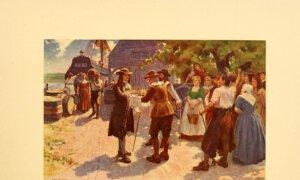George Calvert, Lord Baltimore, requested a charter to begin a colony in the New World. The request was approved by King Charles I in 1632. There is no doubt that Calvert would have been pleased at the news of the approval had he still been alive. Ironically, he died the same year the charter was approved.
The charter, which established the colony’s boundaries between the Atlantic Ocean and Chesapeake Bay with the 40th parallel as its northern border, therefore, went to his eldest son, Cecil, Second Lord Baltimore.
The 26-year-old was now in charge of establishing and governing the Province of Maryland, named after the king’s wife, Queen Henrietta Maria. One of the governing principles for the new colony was the freedom of religion—at least between Catholics and Protestants. It was a reflection of the Protestant king’s marriage to a Catholic princess.
Trouble in England, however, would prove trouble in the colony. Twice, Calvert lost control of the colony for short periods of time due to the outbreak of civil war at home. Nonetheless, he maintained the colony until his death in 1675. The colony remained under the governorship of the Calverts.

Six years after Cecil Calvert’s death, William Penn received his charter for 45,000 square miles for his colony, Pennsylvania. In similar fashion, his charter was provided by the king, now Charles II, who had owed Penn’s father a substantial debt. Pennsylvania was established as a beacon of religious freedom, a safe haven specifically for the persecuted Quakers, a Christian sect to which Penn belonged. Construction for the city of Philadelphia began almost immediately.
Where Is the 40th Parallel ?
Penn’s charter created a confusing territorial map, labeling the southern border as “a circle drawne at twelve miles, distance from New Castle [in Delaware] Northwards, and Westwards unto the beginning of the fortieth degree of Northern Latitude, and then by a straight line Westwards, to the limit of Longitude abovemenconed [sic].” Placing the southern border along the 40th parallel shouldn’t have been a problem, as that would have butted it up against Maryland’s northern border. The problem was that the 40th parallel for Pennsylvania was based on outdated and inaccurate maps. Instead of being built above the 40th parallel, Philadelphia was being constructed under it (39.9526 degrees north to be exact), and in Maryland territory.
The incidental overlapping resulted in a bloody eight-year conflict between Marylanders and Pennsylvanians, ultimately forcing the king to get personally involved.
Encroaching Cresap
Thomas Cresap was born in 1694 in Yorkshire, England. He immigrated to Maryland as a young man. He married Hannah Johnson of Baltimore County in 1727, ultimately settling near her family along the Susquehanna River. Hired as a land agent by Fifth Lord Baltimore, Cresap acquired 150 acres. He and his family moved in 1730 to the river’s west shore. He began his ferry business called Blue Rock Ferry. It seems Cresap, under the direction of Lord Baltimore, began the ferry service to compete directly with the Pennsylvanian John Wright.Wright had begun Wright’s Ferry shortly before Cresap’s arrival. The direct competition was not the only aspect of Cresap’s move that ruffled Pennsylvanian feathers; it was the fact that Cresap was doing so in lands claimed by Pennsylvania, as records showed he was conducting business four miles north of the actual 40th parallel.
Cresap, who by now had acquired a reputation as a frontiersman, an Indian trader, and all-around ruffian, was fully aware of the border dispute and his current place in it. He had earned his nickname as the “Maryland Monster” by Pennsylvanians. In 1731, his mere presence was enough to have him attacked.
Three shots were fired across the Susquehanna, though not at him, but signaling that a party on the other side needed a ride. He and his ferry worker rowed over to ferry three men across the river. As they made their way across, the men grabbed his worker, pushed Cresap into the river (presumably hoping he would drown), and rowed back over to their original side, retaining Cresap’s flatboat and worker.
‘Root Out the ... Villains’
Samuel Blunston was a land surveyor for Lancaster County and a good friend of Wright. He was commissioned to survey areas that would later become Northern York, Cumberland, and Franklin Counties. Having conducted these surveys in 1732 and 1733, he returned to create a pre-warrant system for future Pennsylvania settlers. Blunston, too, was caught in the middle of this border dispute along the Susquehanna, leading him to surmise, “It is a question now whether we shall give up that side of the river to them or defend against them. And if that side were given up, it would seriously affect the inhabitants on this side, where there are already too many malcontents. ... We should root out the nest of villains.”Blunston recommended a defense of the border, especially at Wright’s house, which he noted as the area’s “only garrison.” There had already been a bloody skirmish in Wright’s wheat field. Another would take place in 1735.
Cresap’s Arrest
In September 1736, hundreds of Marylanders and Pennsylvanians formed companies, threatening a battle. At one point, some of the Maryland soldiers broke into the homes of their adversaries and robbed them. A battle, however, never commenced.In November 1736, the border dispute earned the name Cresap’s War. Pennsylvanians accused Cresap of murder. It was enough of a charge to garner a company of 24 armed men, led by the sheriff of Lancaster County, to march onto Cresap’s property, surround his house, and demand his surrender.
Order of the King
The attack on Cresap’s home was enough to force King George II to intervene. The Maryland Council received the king’s command “that the Governors of the respective Provinces of Maryland & Pensylvania for the time being Do not upon pain of incurring his Majestys highest Displeasure permit or Suffer any Tumults, Riots, or other Outrageous Disorders to be Committed on the Borders of their respective Provinces.” King George II ordered the governors of both provinces to desist providing any new land grants until the matter was resolved.
It was a few years before land negotiations made further headway. These included the 1744 Treaty of Lancaster between Maryland, Pennsylvania, Virginia, and the Iroquois Confederation. In 1763, Charles Mason and Jeremiah Dixon, surveyors hired by the Penn and Calvert families, began their four-year survey. The survey, which established borders between four colonies—Maryland, Pennsylvania, Delaware, and Virginia (now West Virginia), became known as the Mason-Dixon Line.








